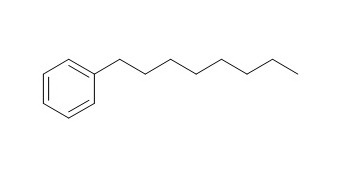1-Phenyloctane
1-Phenyloctane, 1-phenyldecane, 1-methylnaphthalene, and 2-methylnaphthalene,
are four potential laser-induced fluorescence (LIF) tracers for diesel engine applications.
Inquire / Order:
manager@chemfaces.com
Technical Inquiries:
service@chemfaces.com
Tel:
+86-27-84237783
Fax:
+86-27-84254680
Address:
1 Building, No. 83, CheCheng Rd., Wuhan Economic and Technological Development Zone, Wuhan, Hubei 430056, PRC
Providing storage is as stated on the product vial and the vial is kept tightly sealed, the product can be stored for up to
24 months(2-8C).
Wherever possible, you should prepare and use solutions on the same day. However, if you need to make up stock solutions in advance, we recommend that you store the solution as aliquots in tightly sealed vials at -20C. Generally, these will be useable for up to two weeks. Before use, and prior to opening the vial we recommend that you allow your product to equilibrate to room temperature for at least 1 hour.
Need more advice on solubility, usage and handling? Please email to: service@chemfaces.com
The packaging of the product may have turned upside down during transportation, resulting in the natural compounds adhering to the neck or cap of the vial. take the vial out of its packaging and gently shake to let the compounds fall to the bottom of the vial. for liquid products, centrifuge at 200-500 RPM to gather the liquid at the bottom of the vial. try to avoid loss or contamination during handling.
J Ethnopharmacol.2023, 313:116534.
Korean J. of Horticultural Sci. & Tech. 2017, 793-804
Toxicological Research2020, doi: 10.1007.
Molecules.2019, 24(16):E3003
Food Bioscience2024, 58:103691.
Fitoterapia.2022, 157:105130.
Antioxidants.2022, 11(4), 67.
Molecules. 2013, 18(7):7376-88
Curr Issues Mol Biol.2023, ;45(2):1601-1612.
Microchemical Journal2014, 203:110804.
Related and Featured Products
Appl Opt. 2013 Nov 20;52(33):8001-7.
Characterization of four potential laser-induced fluorescence tracers for diesel engine applications.[Pubmed:
24513750]
METHODS AND RESULTS:
Four potential laser-induced fluorescence (LIF) tracers, 1-Phenyloctane, 1-phenyldecane, 1-methylnaphthalene, and 2-methylnaphthalene, are characterized for diesel engine applications. These tracers, embedded in the diesel primary reference fuels n-C₁₆H₃₄ and iso-C₁₆H₃₄, match the relevant physical properties of commercial diesel fuel much better than the commonly used toluene/iso-octane/n-heptane tracer-fuel system does. The temperature and pressure dependencies of the fluorescence intensities and spectra were measured in a flow cell in nitrogen for each candidate tracer molecule. The results show that the signal intensities of the methylnaphthalenes are about two orders of magnitude higher than for 1-Phenyloctane and 1-phenyldecane and show a strong temperature but no pressure, dependence.
CONCLUSIONS:
An analysis of the fluorescence spectrum of 1-methylnaphthalene shows that it also can be used for two-color detection LIF thermometry by choosing appropriate optical filters.
Chem Commun (Camb). 2014 Sep 18;50(72):10456-9.
Comparative STM studies of mixed ligand monolayers on gold nanoparticles in air and in 1-phenyloctane.[Pubmed:
25068154]
Scanning tunnelling microscopy (STM) studies have found stripe-like domains on gold nanoparticles (NPs) coated with certain binary mixtures of ligand molecules. The majority of these NPs' properties have been investigated for particles in solvents. Yet, most STM studies are for NPs in a dry state. Images of the same particles in air and liquid have not been obtained yet.
METHODS AND RESULTS:
In this work, a judicious choice of ligand molecules led to NPs with close-to-ideal STM imaging conditions in air and in 1-Phenyloctane (PO). Large datasets under both conditions were acquired and rapidly evaluated through power spectral density (PSD) analysis.
CONCLUSIONS:
The result is a quantitative comparison of stripe-like domains in air and PO on the same NPs. PSD analysis determines a characteristic length-scale for these domains of ~1.0 nm in air and in PO showing persistence of striped domains in these two media. A length scale of ~0.7 nm for homoligand NPs was found.
Chirality. 2012 Feb;24(2):155-66.
Organization of the enantiomeric and racemic forms of an amphiphilic resorcinol derivative at the air-water and graphite-1-phenyloctane interfaces.[Pubmed:
22180286]
This article describes a study of the outcome of racemate condensation in different types of monolayers.
METHODS AND RESULTS:
The study was performed on a resorcinol surfactant bearing an octadecyl chain and a lactate group which formed a monolayer at the interface of graphite and 1-Phenyloctane as well as a Langmuir film at the air-water interface. Control experiments with the enantiopure materials provided the characteristics of the chiral organizations. The results obtained on the racemate show that on graphite the molecule forms chiral domains, indicating that spontaneous resolution takes place at the surface, a phenomenon that has been rationalized using molecular modeling. The X-ray crystal structure of the DMSO solvate of one of the enantiomers shows a similar type of packing to this monolayer. On the other hand, in the Langmuir layer it appears that the formation of a racemic compound is favoured, as it is in the solid state in three dimensions.
CONCLUSIONS:
The work shows how the symmetry restrictions in different environments can have a critical influence on the outcome of racemate organization, and underline the tendency of graphite to favour symmetry breaking in monolayers formed at its surface.



